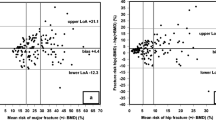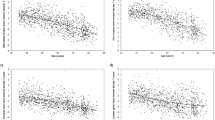Abstract:
Distal forearm fractures are the most common perimenopausal fracture and are generally associated with osteoporosis. The aim of this study was to evaluate the capability of speed of sound (SOS) measurements in cortical bone at the phalanx, radius, tibia and metatarsal to discriminate Colles’ fracture cases from controls in postmenopausal women and to compare this with bone mineral density (BMD) measurements obtained by dual-energy X-ray absorptiometry (DXA). Sixty-three postmenpausal Colles’ fracture cases and 191 postmenopausal controls had SOS measurements of the radius, tibia, phalanx and metatarsal using a semi-reflection ultrasound technique and BMD measurements of the lumbar spine and proximal femur using DXA. The age-adjusted odds ratios (ORs) for fracture for the SOS measurement sites were 1.50 [95% CI 1.07–2.10] for the radius, 1.23 [0.86-1.76] for the tibia, 1.85 [1.06–3.23] for the phalanx and 1.74 [1.12–2.71] for the metatarsal site. For the BMD measurements the ORs were 1.95 [1.34–2.85] for the lumbar spine, 2.21 [1.43–3.40] for the femoral neck and 2.62 [1.69–4.08] for the total hip. The benefits of combining sites either by taking their average Z-score or by using the manufacturer’s ORI algorithm were evaluated. The two methods yielded similar results and the ORs for the combination of the radius and phalanx were 2.00 [1.21–3.33], for the radius and metatarsal 1.67 [1.05–2.67], for the phalanx and metatarsal 1.86 [1.11–3.08] and for the radius, phalanx and metatarsal 1.81 [1.07–3.06]. Combinations of DXA sites gave 2.22 [1.44–3.41] for the lumbar spine and femoral neck and 2.41 [1.57–3.70] for the lumbar spine and total hip. In conclusion, semi-reflection ultrasound measurements at the radius, phalanx or metatarsal demonstrated an ability to discriminate fracture cases from controls in postmenopausal Colles’ fracture patients, although the odds ratios were lower than with spine and femur BMD.
Similar content being viewed by others
Author information
Authors and Affiliations
Additional information
Received: 6 July 2001 / Accepted: 11 December 2001
Rights and permissions
About this article
Cite this article
Knapp, K., Knapp, K., Blake, G. et al. Multisite Quantitative Ultrasound: Colles’ Fracture Discrimination in Postmenopausal Women. Osteoporos Int 13, 474–479 (2002). https://doi.org/10.1007/s001980200057
Published:
Issue Date:
DOI: https://doi.org/10.1007/s001980200057




